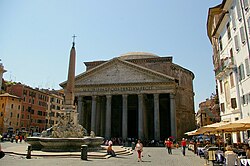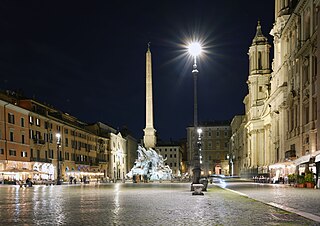
Piazza Navona is a public open space in Rome, Italy. It is built on the site of the 1st century AD Stadium of Domitian and follows the form of the open space of the stadium in an elongated oval. The ancient Romans went there to watch the agones ("games"), and hence it was known as "Circus Agonalis". It is believed that over time the name changed to in avone to navone and eventually to navona.

GiacomoBarozzida Vignola, often simply called Vignola, was one of the great Italian architects of 16th century Mannerism. His two great masterpieces are the Villa Farnese at Caprarola and the Jesuits' Church of the Gesù in Rome. The three architects who spread the Italian Renaissance style throughout Western Europe are Vignola, Serlio and Palladio. He is often considered the most important architect in Rome in the Mannerist era.

Fontana dei Quattro Fiumi is a fountain in the Piazza Navona in Rome, Italy. It was designed in 1651 by Gian Lorenzo Bernini for Pope Innocent X whose family palace, the Palazzo Pamphili, faced onto the piazza as did the church of Sant'Agnese in Agone of which Innocent was the sponsor.

Giacomo della Porta (1532–1602) was an Italian architect and sculptor, who worked on many important buildings in Rome, including St. Peter's Basilica. He was born at Porlezza, Lombardy and died in Rome.

Fontana del Moro is a fountain located at the southern end of the Piazza Navona in Rome, Italy. It depicts a nautical scene with tritons, dolphins, and a conch shell. It was originally designed by Giacomo della Porta in the 1570s with later contributions from Gian Lorenzo Bernini in the 1650s. Bernini sculpted a large terracotta model of the central figure, which Giovanni Antonio Mari used as a guide when sculpting the final figure. There is a debate around whether or not the central figure was intended by Bernini to depict a Moor. Some of the original sculptures were moved to the Galleria Borghese in 1874. In 2011, the fountain was vandalized.
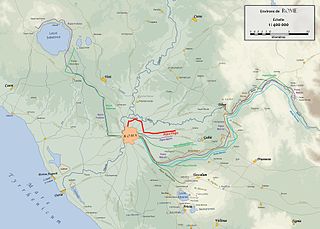
The Aqua Virgo was one of the eleven Roman aqueducts that supplied the city of ancient Rome. It was completed in 19 BC by Marcus Agrippa, during the reign of the emperor Augustus and was built mainly to supply the contemporaneous Baths of Agrippa in the Campus Martius.

Acqua Vergine is one of several Roman aqueducts that deliver pure drinking water to Rome. Its name derives from its predecessor Aqua Virgo, which was constructed by Marcus Vipsanius Agrippa in 19 BC. Its terminal castellum is located at the Baths of Agrippa, and it served the vicinity of Campus Martius through its various conduits. In an effort to restore fresh water to Rome during the Renaissance, Pope Nicholas V, in 1453, renovated the main channels of the Aqua Virgo and added numerous secondary conduits under Campo Marzio. The original terminus, called a mostra, which means showpiece, was the stately, dignified wall fountain designed by Leon Battista Alberti in Piazza dei Crociferi. Due to several additions and modifications to the end-most points of the conduits during the years that followed, during the Renaissance and Baroque periods, the Acqua Vergine culminated in several magnificent mostre - the Trevi Fountain and the fountains of Piazza del Popolo.

Piazza del Popolo is a large urban square in Rome. The name in modern Italian literally means "People's Square", but historically it derives from the poplars after which the church of Santa Maria del Popolo, in the northeast corner of the piazza, takes its name.

Filippo Barigioni (1690–1753) was an Italian sculptor and architect working in the Late Baroque tradition.

The Fontana di Piazza Nicosia is a fountain in Rome, Italy, is the first of the modern fountains of Rome. It is located in the square with the same name.

The fountain in the Piazza d'Aracoeli is a fountain in Rome, Italy, located at the base of the Capitoline Hill, in the little square with the same name.
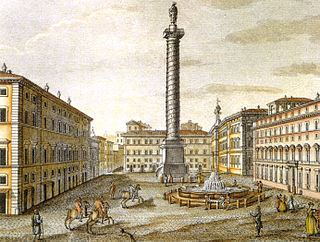
The fountain in the Piazza Colonna is a fountain in Rome, Italy, designed by the architect Giacomo Della Porta and constructed by the Fiesole sculptor Rocco Rossi between 1575 and 1577.

The Fontana del Pantheon was commissioned by Pope Gregory XIII and is located in the Piazza della Rotonda, Rome, in front of the Roman Pantheon. It was designed by Giacomo Della Porta in 1575 and sculpted out of marble by Leonardo Sormani.

The Fontana delle Tartarughe is a fountain of the late Italian Renaissance, located in Piazza Mattei, in the Sant'Angelo district of Rome, Italy. It was built between 1580 and 1588 by the architect Giacomo della Porta and the sculptor Taddeo Landini. The bronze turtles around the upper basin, usually attributed either to Gian Lorenzo Bernini or Andrea Sacchi, were added in either 1658 or 1659 when the fountain was restored.

The Fontana dell'Acqua Felice, also called the Fountain of Moses, is a monumental fountain located in the Quirinale District of Rome, Italy. It marked the terminus of the Acqua Felice aqueduct restored by Pope Sixtus V. It was designed by Domenico Fontana and built in 1585–1588. It is located at the intersection of Largo Santa Susanna and Via Venti Settembre; across and diagonal from the Largo, is the church of Santa Susanna, while across Via Venti Settembre is the church of Santa Maria della Vittoria.
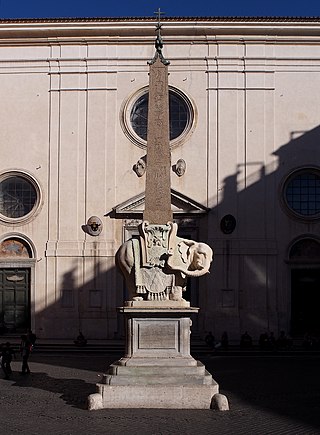
Elephant and Obelisk is a statue of an elephant carrying an obelisk, designed by the Italian artist Gian Lorenzo Bernini. It was unveiled in 1667 in the Piazza della Minerva in Rome, adjacent to the church of Santa Maria sopra Minerva, where it stands today.

The Fountain of the Tritons is a fountain in Rome (Italy), Piazza Bocca della Verità, in front of the basilica of Santa Maria in Cosmedin. This fountain should be distinguished from the similarly named nearby Triton Fountain by Gian Lorenzo Bernini, in the Piazza Barberini, with only a single Triton.

The Baths of Nero or Baths of Alexander were a complex of ancient Roman baths on the Campus Martius in Rome, built by Nero in either 62 or 64 and rebuilt by Alexander Severus in 227 or 229. It stood between the Pantheon and the Stadium of Domitian and were listed among the most notable buildings in the city by Roman authors and became a much-frequented venue. These thermae were the second large public baths built in Rome, after the Baths of Agrippa, and it was probably the first "imperial-type" complex of baths, with a monumental scale and symmetrical, axially-planned design. While in the sixteenth century the foundations of the caldarium were still visible, nothing else of the structure remains above ground except some fragments of walls incorporated into the structure of Palazzo Madama.
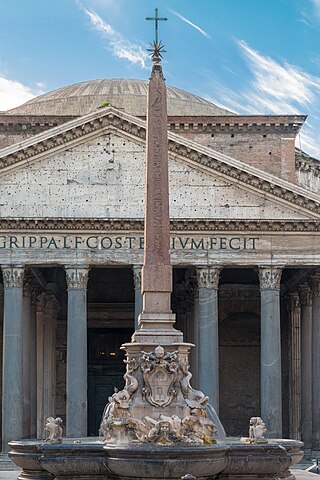
The Pantheon obelisk or Obelisco Macuteo is an Egyptian obelisk in Rome in Piazza della Rotonda in front of the Pantheon on a fountain. It is one of the 13 obelisks in Rome and one of relatively few ancient monoliths. It is 6.34 m high.
